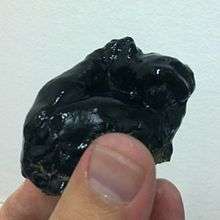Phallusia nigra
Phallusia nigra is a solitary marine tunicate of the ascidian class found in tropical seas around the world. It usually lives in shallow waters, attached to any hard substrate.[2][3]
| Phallusia nigra | |
|---|---|
 | |
| Scientific classification | |
| Kingdom: | |
| Phylum: | |
| Class: | |
| Order: | |
| Family: | |
| Genus: | |
| Species: | P. nigra |
| Binomial name | |
| Phallusia nigra | |
| Synonyms[1] | |
| |
Like all tunicates, P. nigra has a thick leathery envelope (tunic) containing cellulosic material. Like all solitary ascidians, the tunic encloses a sac-shaped body with separate water entrance and exit tubes (siphons). It lives on plankton that it filters from seawater with a mucous net. This tunicate is often host to the small symbiotic pea crab Tunicotheres moseri which takes up residence in its atrial chamber.[4]
An adult P. nigra may be 10 cm (4 in) long. The tunic is usually velvet black or dark brown, but may be gray in specimens that are younger or live in shaded areas. Its original range is unclear; the tropical Western Atlantic Ocean, the Red Sea, and the Indian Ocean have been proposed.[2]
The tunic of P. nigra contains many vesicles filled with a strong acid (with pH near 1), containing mostly sulphate SO
42− and chloride (Cl−
) anions. The vesicles are concentrated towards the outer surface and are easily ruptured by contact; they are believed to protect the animal from predation and fouling.[5]
Substances extracted from the dried tunic with methanol have been found to have cytotoxic, antibacterial, antipyretic, analgesic, and histamine-like activity.[6][7][8]
References
- Sanamyan, K.; Monniot, C. (2012). Shenkar N, Gittenberger A, Lambert G, Rius M, Moreira Da Rocha R, Swalla BJ, Turon X (eds.). "Phallusia nigra Savigny, 1816". Ascidiacea World Database. World Register of Marine Species. Retrieved 2012-10-26.CS1 maint: multiple names: authors list (link)
- "Phallusia nigra". Bishop Museum, University of Hawaii. Accessed on 2011-11-23.
- Rocha, Rosana Moreira da; Lotufo, Tito Monteiro da Cruz; Rodrigues, Sérgio de Almeida (January 1999). "The biology of Phallusia nigra Savigny, 1816 (Tunicata: Ascidiacea) in southern Brazil: Spatial distribution and reproductive cycle". Bulletin of Marine Science. 64 (1): 77–88. INIST:1785659.
- Lopez Greco, L.S.; Bolanos, J.; Rodriguez, Marcelo; Hernandez, G. (2001). "Survival and Molting of the Pea Crab Larvae Tunicotheres moseri Rathbun 1918 (Brachyura, Pinnotheridae) Exposed to Copper". Archives of Environmental Contamination and Toxicology. 40: 505–510. doi:10.1007/s002440010203.
- Hirose, Euichi; Yamashiro, Hideyuki; Mori, Yasuaki (2001). "Properties of Tunic Acid in the Ascidian Phallusia nigra (Ascidiidae, Phlebobranchia)". Zoological Science. 18 (3): 309–14. doi:10.2108/zsj.18.309.
- Jaffarali, Hajamohideen Abdul; Tamilselvi, Madasamy; Sivakumar, Velayudham (2008). "Antibacterial activity of the marine ascidians Phallusia nigraand Herdmania pallida from the Tuticorin coast, India" (PDF). Journal of Biological Research-Thessaloniki. 10: 171–9.
- Costa, LV; Malpezzi, EL; Matsui, DH; Machado-Santelli, GM; Freitas, JC (1996). "Cytotoxic activity of a methanol extract of Phallusia nigra (Tunicata, Ascidiacea)". Brazilian Journal of Medical and Biological Research. 29 (3): 367–73. PMID 8736132.
- Costa, Letı́cia V; Malpezzi, Elena L.A; Berlinck, Roberto G.S; Rowan, Edward G; De Freitas, José Carlos (1997). "This Histamine-Like Effects of Phallusia nigra Extract: Evidences for Direct Activity at H1 Receptors". Comparative Biochemistry and Physiology C. 117 (1): 111–5. doi:10.1016/S0742-8413(96)00228-9. PMID 9185333.